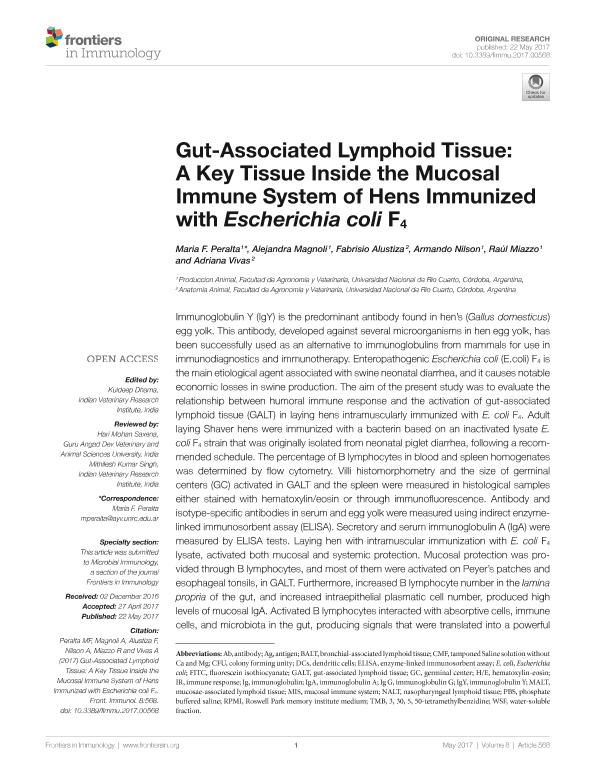Mostrar el registro sencillo del ítem
dc.contributor.author
Peralta, Maria Fernanda

dc.contributor.author
Magnoli, Alejandra Paola

dc.contributor.author
Alustiza, Fabricio
dc.contributor.author
Nilson, Armando Jesús

dc.contributor.author
Miazzo, Raul Daniel

dc.contributor.author
Vivas, Adriana Beatriz

dc.date.available
2022-05-19T20:45:53Z
dc.date.issued
2017-05-22
dc.identifier.citation
Peralta, Maria Fernanda; Magnoli, Alejandra Paola; Alustiza, Fabricio; Nilson, Armando Jesús; Miazzo, Raul Daniel; et al.; Gut-Associated Lymphoid Tissue: A Key Tissue Inside the Mucosal Immune System of Hens Immunized with Escherichia coli F4; Frontiers Media; Frontiers in Immunology; 8; 568; 22-5-2017; 1-11
dc.identifier.issn
1664-3224
dc.identifier.uri
http://hdl.handle.net/11336/157859
dc.description.abstract
Immunoglobulin Y (IgY) is the predominant antibody found in hen’s (Gallus domesticus) egg yolk. This antibody, developed against several microorganisms in hen egg yolk, has been successfully used as an alternative to immunoglobulins from mammals for use in immunodiagnostics and immunotherapy. Enteropathogenic Escherichia coli (E.coli) F4 is the main etiological agent associated with swine neonatal diarrhea, and it causes notable economic losses in swine production. The aim of the present study was to evaluate the relationship between humoral immune response and the activation of gut-associated lymphoid tissue (GALT) in laying hens intramuscularly immunized with E. coli F4. Adult laying Shaver hens were immunized with a bacterin based on an inactivated lysate E. coli F4 strain that was originally isolated from neonatal piglet diarrhea, following a recommended schedule. The percentage of B lymphocytes in blood and spleen homogenates was determined by flow cytometry. Villi histomorphometry and the size of germinal centers (GC) activated in GALT and the spleen were measured in histological samples either stained with hematoxylin/eosin or through immunofluorescence. Antibody and isotype-specific antibodies in serum and egg yolk were measured using indirect enzymelinked immunosorbent assay (ELISA). Secretory and serum immunoglobulin A (IgA) were measured by ELISA tests. Laying hen with intramuscular immunization with E. coli F4 lysate, activated both mucosal and systemic protection. Mucosal protection was provided through B lymphocytes, and most of them were activated on Peyer’s patches and esophageal tonsils, in GALT. Furthermore, increased B lymphocyte number in the lamina propria of the gut, and increased intraepithelial plasmatic cell number, produced high levels of mucosal IgA. Activated B lymphocytes interacted with absorptive cells, immune cells, and microbiota in the gut, producing signals that were translated into a powerful physical defense by producing a greater volume of mucin from an increased number of goblet cells. Systemic protection was provided through B lymphocyte activation of spleen GC, which produced hugely specific IgY serum levels. One week later, this specific IgY was deposited in the yolk. This suggests that GALT is a key immunologic tissue inside the mucosal immune system, acting as the “command center” for humoral reaction.
dc.format
application/pdf
dc.language.iso
eng
dc.publisher
Frontiers Media

dc.rights
info:eu-repo/semantics/openAccess
dc.rights.uri
https://creativecommons.org/licenses/by/2.5/ar/
dc.subject
GUT-ASSOCIATED LYMPHATIC TISSUE
dc.subject
B LYMPHOCYTES
dc.subject
HEN
dc.subject
IMMUNOGLOBULIN Y TECHNOLOGY
dc.subject.classification
Otras Ciencias Veterinarias

dc.subject.classification
Ciencias Veterinarias

dc.subject.classification
CIENCIAS AGRÍCOLAS

dc.title
Gut-Associated Lymphoid Tissue: A Key Tissue Inside the Mucosal Immune System of Hens Immunized with Escherichia coli F4
dc.type
info:eu-repo/semantics/article
dc.type
info:ar-repo/semantics/artículo
dc.type
info:eu-repo/semantics/publishedVersion
dc.date.updated
2022-05-12T16:52:08Z
dc.journal.volume
8
dc.journal.number
568
dc.journal.pagination
1-11
dc.journal.pais
Suiza

dc.journal.ciudad
Lausana
dc.description.fil
Fil: Peralta, Maria Fernanda. Universidad Nacional de Río Cuarto. Facultad de Agronomía y Veterinaria. Departamento de Producción Animal; Argentina
dc.description.fil
Fil: Magnoli, Alejandra Paola. Universidad Nacional de Río Cuarto. Facultad de Agronomía y Veterinaria. Departamento de Producción Animal; Argentina. Universidad Nacional de Rio Cuarto. Facultad de Agronomia y Veterinaria. Instituto de Ciencias Veterinarias. - Consejo Nacional de Investigaciones Cientificas y Tecnicas. Centro Cientifico Tecnologico Conicet - Cordoba. Instituto de Ciencias Veterinarias.; Argentina
dc.description.fil
Fil: Alustiza, Fabricio. Universidad Nacional de Río Cuarto. Facultad de Agronomía y Veterinaria. Departamento de Anatomía Animal; Argentina
dc.description.fil
Fil: Nilson, Armando Jesús. Universidad Nacional de Río Cuarto. Facultad de Agronomía y Veterinaria. Departamento de Producción Animal; Argentina
dc.description.fil
Fil: Miazzo, Raul Daniel. Universidad Nacional de Río Cuarto. Facultad de Agronomía y Veterinaria. Departamento de Producción Animal; Argentina
dc.description.fil
Fil: Vivas, Adriana Beatriz. Universidad Nacional de Río Cuarto. Facultad de Agronomía y Veterinaria. Departamento de Anatomía Animal; Argentina
dc.journal.title
Frontiers in Immunology
dc.relation.alternativeid
info:eu-repo/semantics/altIdentifier/url/https://www.frontiersin.org/articles/10.3389/fimmu.2017.00568/full
dc.relation.alternativeid
info:eu-repo/semantics/altIdentifier/doi/http://dx.doi.org/10.3389/fimmu.2017.00568
Archivos asociados
